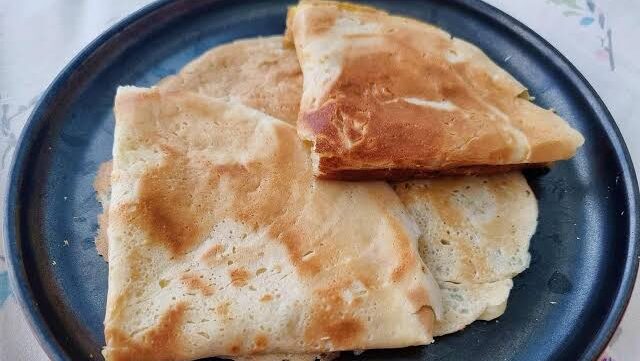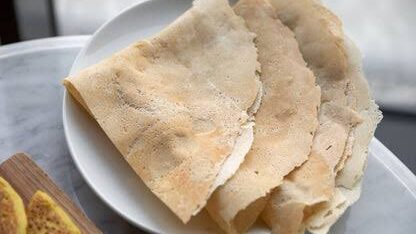Tucked away in the heart of the UAE’s rich and diverse cultural landscape is a unique treasure that often goes under the radar of both locals and visitors alike – the regag. A traditional dish with deep roots in the UAE’s culinary history, regag has long been a favorite snack or breakfast item in many Emirati households. In this article, we will explore the origins, preparation, significance, and modern-day variations of this iconic food item, shedding light on why it remains a cherished part of the region’s culture.
What is Regag?
Regag is a traditional Emirati flatbread, known for its thin, crispy texture and simple yet flavorful taste. Often likened to a crepe or a type of flatbread, it is made from a mixture of basic ingredients such as flour, water, and salt, and can be cooked on a large griddle or in a traditional clay oven called a “tandoor.” The flatbread is typically served with various fillings or toppings, making it a versatile dish that can be enjoyed as a snack or a meal.
The beauty of regag lies in its simplicity. Though its ingredients are minimal, the end result is a delicious, crispy bread that pairs well with a variety of condiments, making it a staple in Emirati cuisine.


A Taste of Tradition: The Origins of Regag
The origins of regag are deeply rooted in the rich cultural history of the UAE. Like many traditional dishes in the Middle East, regag has been passed down through generations, evolving over time but maintaining its core identity. The dish is believed to have been introduced by nomadic Bedouins who relied on portable ingredients and simple cooking techniques to sustain themselves during their travels across the desert.
In its early days, regag was often cooked in open fires, which gave it a smoky flavor, and was served alongside various meats, dates, and dairy products. The flatbread quickly became a popular option because it was easy to prepare and could be paired with a wide range of dishes, making it ideal for both daily meals and special occasions.
The Preparation of Regag: A Simple Yet Skillful Process
Preparing regag is an art that requires patience, skill, and a deep understanding of the traditional methods used by generations before. To make regag, flour is first mixed with water and salt to form a dough. The dough is then divided into small balls, which are rolled out into very thin, almost translucent layers. The thin dough is then cooked on a griddle or tawa, where it is pressed with a cloth to ensure it cooks evenly and crisps up to a perfect golden-brown color.
One of the key features of regag is its texture. When done correctly, the bread should be thin and crisp, with a slight chewiness in the center. The traditional method of pressing the bread with a cloth while it cooks gives regag its characteristic thinness and crispiness. This technique also helps to trap the heat inside, ensuring that the bread remains soft and pliable until it is served.
Regag: A Versatile Dish with Endless Variations
Although regag is simple in its base form, it can be modified in numerous ways to cater to different tastes. Traditionally, it was often served with savory fillings such as cheese, eggs, or meat. However, over the years, the dish has evolved to include both sweet and savory variations, making it a versatile meal or snack.
1. Savory Regag
One of the most popular savory variations of regag is the “cheese regag.” The thin flatbread is spread with a layer of melted cheese and other savory fillings such as olives, tomatoes, or pickles. This version is often enjoyed as a quick breakfast or a light snack.
Another savory option includes regag with eggs, where the bread is topped with scrambled eggs, herbs, and spices. For those who prefer heartier meals, regag can also be filled with grilled meats or vegetables, offering a satisfying and flavorful dish.
2. Sweet Regag
While savory regag options are more common, the dish can also be prepared in sweet variations, often served as a dessert. A popular sweet version of regag includes the addition of honey, sugar, and butter. The combination of these ingredients gives the flatbread a rich, sweet flavor, making it an indulgent treat after a meal or as an afternoon snack.
For those with a taste for exotic flavors, sweet regag can also be paired with dates, chocolate, or even fruit, creating a mouthwatering dessert that blends traditional Emirati flavors with contemporary twists.
Regag in Modern Emirati Life
While regag has been a staple in traditional Emirati cuisine for centuries, it remains relevant and loved in modern-day UAE. The simplicity of the dish makes it easy to prepare in a fast-paced world, while its versatility ensures that it can be enjoyed in many forms – whether as a quick breakfast, a hearty lunch, or a snack to accompany tea in the afternoon.
Regag is often served in cafes and restaurants, especially in traditional eateries that focus on offering authentic Emirati food. In these settings, the dish is usually accompanied by a variety of dips or sides, such as hummus, labneh, or a mix of pickles and salads.
1. Regag and Emirati Hospitality
The role of regag extends beyond just being a food item. It is also an important part of Emirati hospitality and is often served to guests as a gesture of welcome and generosity. Whether during a special occasion or a casual gathering, offering regag to visitors is a symbolic act of friendship and respect. Its warm, comforting nature makes it a fitting dish to share with loved ones and strangers alike.
2. Regag and the UAE’s Modern Food Scene
In the context of the UAE’s diverse and evolving food scene, regag is gaining recognition as part of the nation’s culinary heritage. Emirati cuisine, including dishes like regag, is now being celebrated at both local and international food festivals. Modern chefs are taking traditional recipes like regag and giving them a contemporary spin, adding ingredients such as truffle oil, gourmet cheeses, and other high-end ingredients. This fusion of traditional and modern techniques is helping regag maintain its relevance and popularity.
Regag’s Cultural Significance
More than just a dish, regag has come to represent a connection to the UAE’s past and its cultural heritage. In a rapidly modernizing society, dishes like regag offer a window into the traditions of the country, serving as a reminder of simpler times. As the UAE continues to develop as a global hub for trade, business, and tourism, the preservation and celebration of traditional foods like regag play a crucial role in maintaining the nation’s cultural identity.
Regag also serves as a symbol of the UAE’s culinary diversity. It is enjoyed by people of all backgrounds and is a perfect example of how food can transcend boundaries and bring people together.
Conclusion: A Dish Worth Remembering
Regag, with its simple ingredients and timeless appeal, remains one of the UAE’s most cherished dishes. Whether enjoyed with savory fillings or sweet toppings, it offers a perfect balance of taste and texture, making it a beloved snack for both locals and visitors. Beyond its culinary appeal, regag is a dish steeped in history, cultural significance, and a testament to the UAE’s vibrant traditions.
As Emirati cuisine continues to grow in prominence, regag stands as a symbol of the country’s rich heritage, reminding us of the beauty found in simplicity and the warmth that a shared meal can bring. For those seeking an authentic taste of the UAE, regag is a must-try, offering a delightful glimpse into the heart and soul of Emirati culture.
Do follow Uae stories for more Updates
Sharjah Book Fair: Celebrating Literature and Culture in the Heart of the UAE













